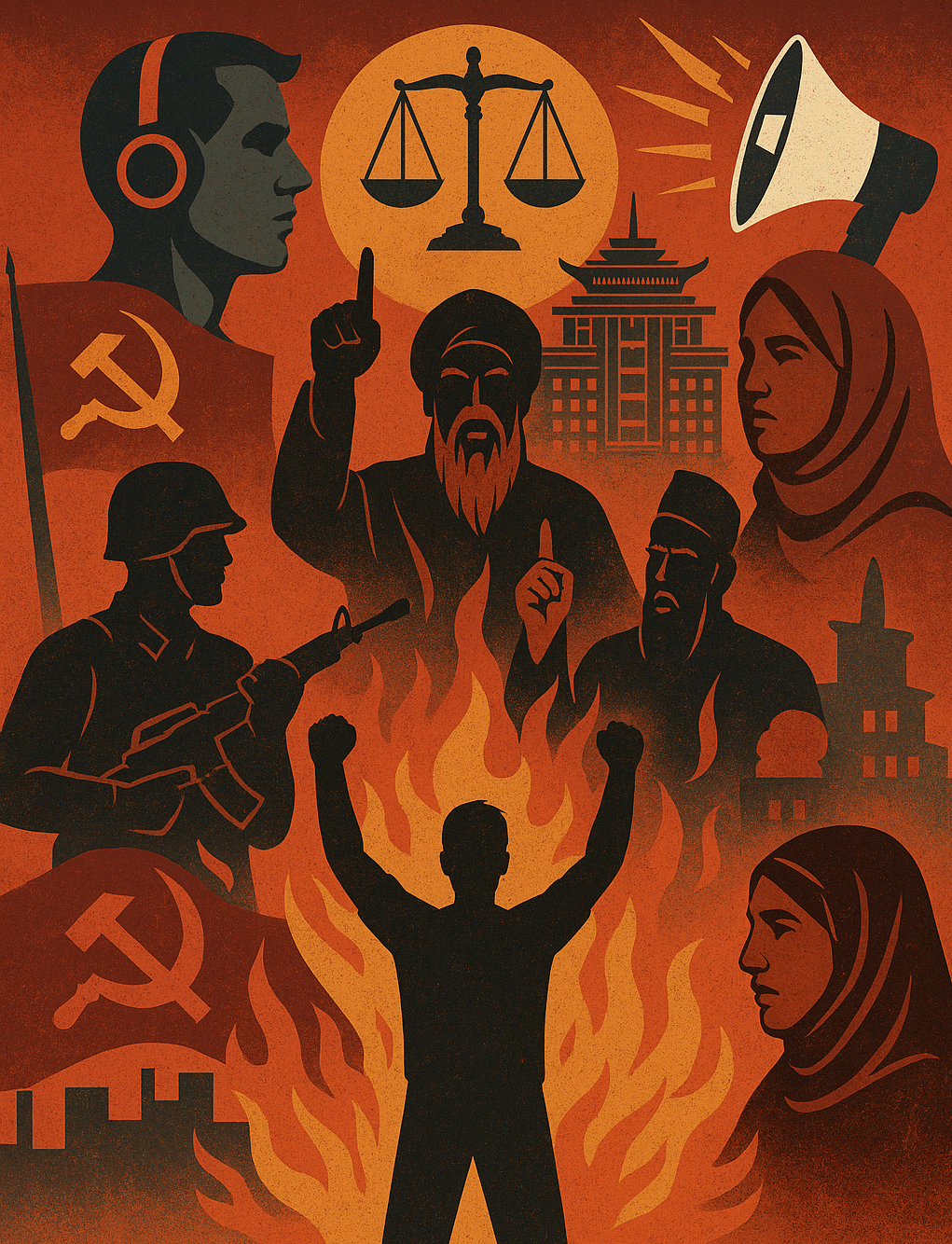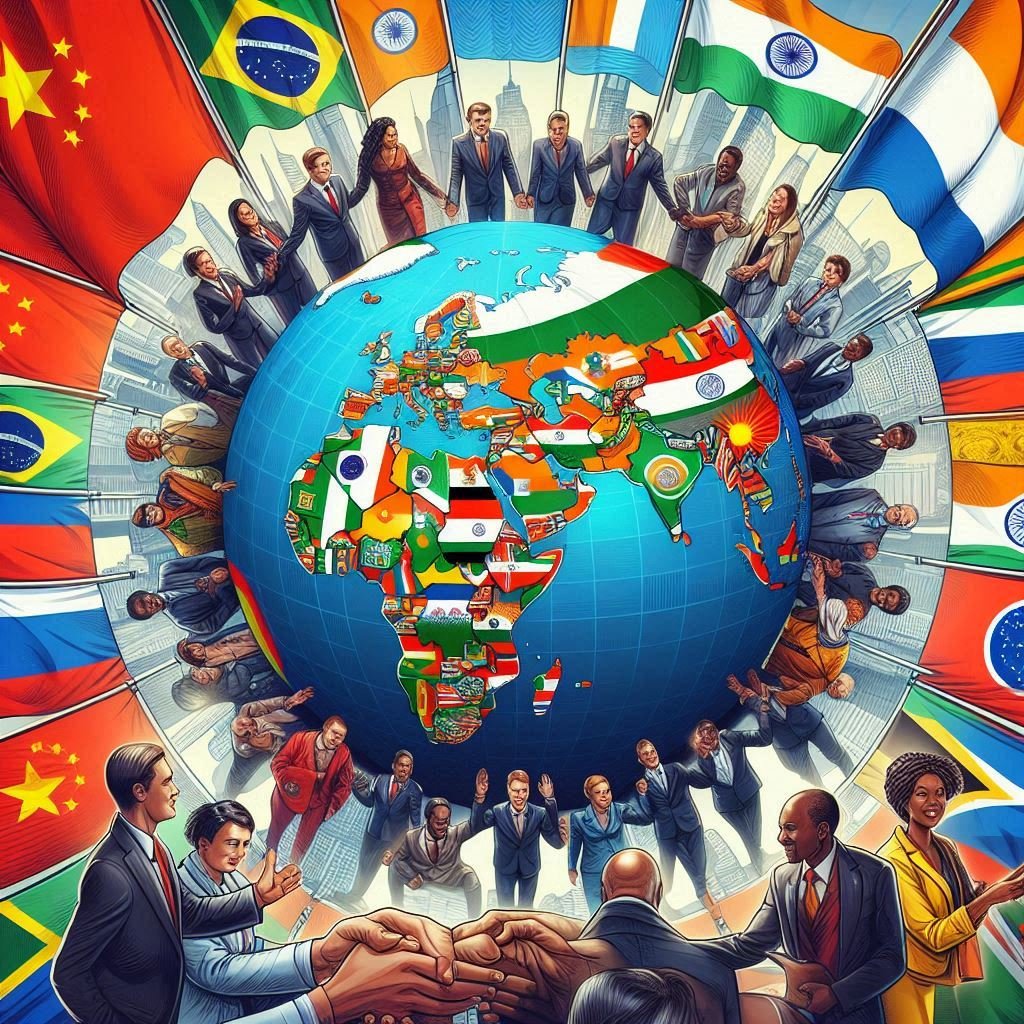
A snarky exploration of how propaganda, poverty, and patriarchy turn citizens into ready-made drone-sheeps.
Radicalization – a simple word – yet it is a deeply complex and multifaceted process involving political, social, cultural, and economic mechanisms. This process is not merely state-driven but can emerge from a combination of state actions, societal pressures, and individual psychological factors.
1) State Radicalization: The Role of the State in Shaping Extremism
State radicalization occurs when governments either intentionally or unintentionally foster extreme ideologies, often to consolidate power or maintain control.
This manipulation can involve both direct and indirect means, ranging from propaganda and education to repression and violence.
The state’s influence in radicalizing citizens is historically evident and continues to manifest in modern regimes.
A. Propaganda and Ideological Control
States often use state-controlled media to shape public opinion, promote specific ideologies, and demonize perceived enemies.
Totalitarian regimes like Nazi Germany and Soviet Russia were notorious for using state-run media to radicalize their citizens, promoting nationalism, anti-Semitism, or Marxist-Leninist doctrines.
In modern times, regimes such as North Korea continue to utilize propaganda to reinforce a radicalized worldview, often portraying the West—especially the United States—as the enemy.
B. Education and Indoctrination
Education is another powerful tool for radicalization. Governments can influence the education system to indoctrinate youth with a specific worldview. For example, Fascist Italy and Nazi Germany used their educational systems to instill loyalty to the state and radicalize youth into accepting totalitarian doctrines.
State-controlled curricula often teach ideologies that justify violence or the suppression of perceived enemies, making education a key vehicle for radicalization.
C. State-Sponsored Violence and Repression
In times of conflict, authoritarian regimes often use violence and repression to radicalize citizens. The creation of an “us vs. them” mentality can heighten societal tensions, pushing individuals toward radical views or resistance movements.
The French colonial authorities in the Algerian War of Independence, for instance, used brutal tactics that radicalized both the French settlers and the Algerian resistance.
This form of radicalization thrives in environments where state violence is routine, and citizens become either perpetrators or victims of extremism.
D. Military Service and Nationalism
Conscription and militarism often play a role in state radicalization. Many states promote nationalism through mandatory national service, cultivating blind loyalty to the state.
In military regimes, this practice strengthens nationalistic sentiment, sometimes leading to radicalized ideologies that justify militarized actions.
Latin American military regimes in the 20th century utilized conscription to generate blind loyalty to the state and its objectives, contributing to the rise of radicalized citizenry.
Several examples from history illustrate how states have used various mechanisms to radicalize their citizens.
- Nazi Germany
Under Adolf Hitler, the Nazi state utilized propaganda, education, and mass repression to radicalize its citizens. Nationalist fervor and anti-Semitism were institutionalized, with the state framing Jews as the enemy. This radicalization was not limited to adults but was also instilled in youth through state-controlled education, propaganda, and youth organizations.
- Soviet Union
Stalinist Russia relied on ideological propaganda, mass purges, and a climate of fear to radicalize its citizens. The Communist Party controlled the media and education system, promoting Marxist-Leninist ideology while suppressing opposition. Over time, these mechanisms created a sense of loyalty to the regime, making citizens more susceptible to radical ideologies that justified state violence and authoritarianism.
- North Korea
North Korea’s Kim regime has used heavy indoctrination, surveillance, and a cult of personality to radicalize its citizens. Every aspect of life, from education to family relations, is controlled by the state, promoting a worldview that casts the West—particularly the U.S.—as the enemy. The ideological framework of Juche (self-reliance) further entrenches citizens into a radicalized narrative.
Several political theorists have explored the role of the state in radicalizing its citizens.
- Michel Foucault
Foucault’s theory of “biopower” describes how states regulate citizens’ lives through surveillance, discipline, and knowledge. In his view, states can radically influence citizens by controlling how they think, live, and interact with others. Foucault’s ideas highlight how power structures can push individuals toward radicalization by controlling all aspects of life.
- Carl Schmitt
Schmitt argues that states often construct the concept of the “enemy” to justify extraordinary measures. This “us versus them” mentality can radicalize citizens who are encouraged to see themselves as defenders of the state or ideology, particularly in times of crisis.
- Max Weber
Weber’s theory of the state’s monopoly on violence discusses how the state’s control over political and social coercion can lead to the formation of radical ideologies. Weber’s analysis shows how state power and the ability to use force can lead to the development of extreme ideas that justify violence.
- Hannah Arendt
Arendt’s exploration of totalitarianism illustrates how states strip individuals of their identities, pushing them toward conformity to state ideology. In her works, particularly The Origins of Totalitarianism, Arendt explains how fear, loneliness, and the desire for certainty make people more vulnerable to radical ideologies promoted by totalitarian regimes.
- Antonio Gramsci
Gramsci’s concept of cultural hegemony emphasizes the state’s use of cultural institutions—media, education, religion—to shape public opinion. According to Gramsci, the state doesn’t only rely on coercion but also uses cultural and ideological mechanisms to promote certain narratives, contributing to radicalization.
2) Human Conditions That Lead to Radicalization
While state-driven radicalization is important, human conditions also play a significant role. Socioeconomic factors, political instability, and social exclusion create an environment where radical ideologies can take root. The following conditions increase susceptibility to radicalization:
A. Poverty and Economic Inequality
Economic hardship is one of the most common conditions that lead to radicalization. In regions with extreme poverty and unemployment, individuals often see little to no opportunity for upward mobility. Radical ideologies can provide an alternative narrative that promises change or a way out. In many conflict zones, such as Iraq and Syria, individuals have joined groups like ISIS in search of status, purpose, and financial stability.
B. Political Instability and Oppression
In politically unstable regions or under authoritarian regimes, citizens often feel disillusioned with the state and its institutions. In countries like Sudan and Egypt, where political repression is common, radical groups find fertile ground for recruitment. The lack of democratic avenues for political expression pushes individuals toward more extreme forms of opposition.
C. Social Exclusion and Identity Crisis
Marginalized communities—whether based on ethnicity, religion, or other social factors—are often at risk of radicalization. When these groups feel socially excluded or oppressed, they may adopt radical ideologies in defense of their identity. For example, in Nigeria, groups like Boko Haram have recruited disaffected individuals who feel oppressed by the government and society.
D. Lack of Education and Information
In many developing countries, the lack of access to quality education leaves individuals vulnerable to extremist ideologies. Without critical thinking skills or access to diverse perspectives, individuals may find radical ideologies appealing, especially if they promise simple answers to complex problems. This is particularly evident in regions with high illiteracy rates, such as parts of Afghanistan and Pakistan.
E. Conflict and War
Prolonged conflict exacerbates poverty, oppression, and social exclusion, further increasing the likelihood of radicalization. In war-torn regions like Syria, ISIS has exploited the chaos and instability, recruiting individuals—especially the young—who have lost family members, homes, and livelihoods.
3) The Role of Patriarchy in Radicalization
Patriarchy plays a key role in radicalization, especially in countries like Pakistan, Iran, India, and Afghanistan, where deeply entrenched gender norms contribute to societal frustration and political instability. Patriarchal systems, which restrict women’s rights and reinforce rigid gender roles, often suppress individuals, especially women and marginalized groups, creating fertile ground for radical ideologies.
A. Social and Psychological Pressure
In patriarchal societies, individuals—especially women—face immense social pressure to conform to traditional gender roles. The frustration of being denied basic rights, such as education or autonomy, often leads to a sense of helplessness. This can result in the radicalization of those who feel oppressed and alienated. For men, the pressure to conform to masculine ideals of dominance and control can foster susceptibility to extremist ideologies that promise empowerment or reassert dominance.
B. Repression of Dissent and Identity Crisis
Patriarchy not only limits individual freedom but also suppresses political, religious, and social dissent. Youth, particularly in patriarchal societies, often experience an identity crisis, feeling disconnected from the values and institutions of the state. This disillusionment can push individuals toward radical ideologies that promise a new order. For example, in countries like Afghanistan, where patriarchal interpretations of Islam are used to justify radical policies, young men may turn to extremist groups in search of religious fulfillment and social belonging.
C. Economic and Social Marginalization
In patriarchal societies, economic inequalities and social exclusion contribute to radicalization. Women, particularly in rural areas, are often excluded from education, employment, and property rights, leading to a sense of economic and social marginalization. Youth, especially from impoverished backgrounds, are particularly vulnerable to radicalization. Radical groups often promise empowerment, respect, and opportunities that are otherwise unavailable.
D. Disruption of Traditional Power Structures
As societies experience rapid political, social, or cultural changes, traditional patriarchal structures are often threatened. This creates a backlash in which radical ideologies gain traction, particularly those that promise to restore the traditional social order. In countries like Iran, where the revolution led to the reassertion of patriarchal control under the guise of Islamic rule, radical ideologies that emphasize gender segregation and female subjugation are embraced by certain sections of the population.
Radical ideas have often been the catalyst for societal change—both for better and worse. While some radicals have sparked revolutions that led to greater social justice, equality, and liberation, others have promoted ideologies that fueled violence, division, and oppression. Below, we explore the legacies of some of history’s most famous radicals, highlighting their positive and negative impacts on society.
- Karl Marx (1818-1883)
Marx’s ideas laid the foundation for socialist and communist movements worldwide. His critiques of capitalism and his vision for a classless society inspired revolutions, particularly in the 20th century, leading to the establishment of socialist states such as the Soviet Union and China. His theory of historical materialism and class struggle continues to influence political thought today.
The implementation of Marxist ideas in practice, particularly under regimes like Stalin’s Soviet Union and Mao’s China, led to authoritarian regimes that suppressed political opposition and engaged in widespread human rights abuses. While Marx envisioned a stateless society, the reality of state-controlled economies and violent revolutions often contradicted his utopian ideals.
- Che Guevara (1928-1967)
As a key figure in the Cuban Revolution, Guevara became an icon of revolutionary struggle. His commitment to fighting imperialism and social injustice, especially in Latin America, inspired countless activists and guerrilla fighters around the world. Guevara’s belief in the necessity of armed resistance against oppressive regimes sparked social movements focused on liberation and anti-imperialism.
Guevara’s advocacy for armed revolution and guerrilla warfare also led to violence and the loss of innocent lives. His later efforts in Congo and Bolivia were unsuccessful, and some view his radical methods as contributing to the militarization of social movements, which sometimes turned violent and counterproductive.
- Malcolm X (1925-1965)
Malcolm X’s radical ideas about race, identity, and self-defense transformed the civil rights movement in America. His advocacy for Black pride, economic empowerment, and self-determination inspired generations of African Americans to stand up for their rights. His break from mainstream civil rights leaders, his rejection of nonviolence, and his call for a global Black revolution empowered oppressed communities worldwide.
Some of Malcolm X’s early views, particularly his call for racial separation and his strong rhetoric against white Americans, alienated potential allies. However, in his later years, Malcolm X softened his stance after embracing a more inclusive vision of civil rights following his pilgrimage to Mecca.
Addressing the Root Causes of Radicalization
The radicalization of citizens by the state is a multifaceted process that involves the intersection of political, social, and human factors. State-driven radicalization often occurs through propaganda, education, repression, and violence, while societal conditions—such as poverty, political instability, and patriarchal structures—further contribute to this process. Radical ideologies can gain traction when individuals feel alienated, marginalized, or powerless.
To address the root causes of radicalization, it is crucial to dismantle oppressive systems, whether they be patriarchal, political, or economic. Providing access to education, promoting social justice, and supporting inclusive political structures can help reduce the vulnerability of individuals to radical ideologies. Moreover, challenging state repression, promoting critical thinking, and fostering a sense of belonging and empowerment can prevent the rise of extremism.
By addressing both the human conditions and the state mechanisms that foster radicalization, societies can work toward reducing extremism and creating a more inclusive, peaceful world.







